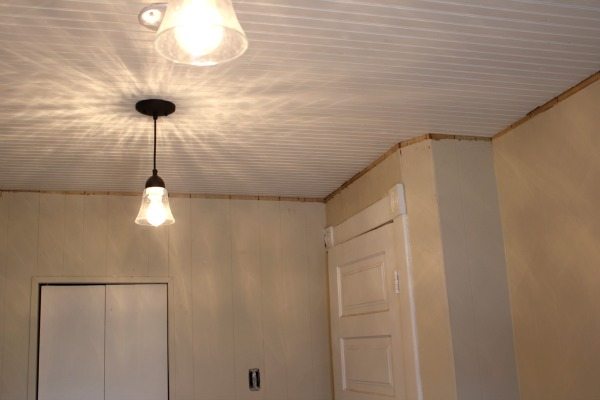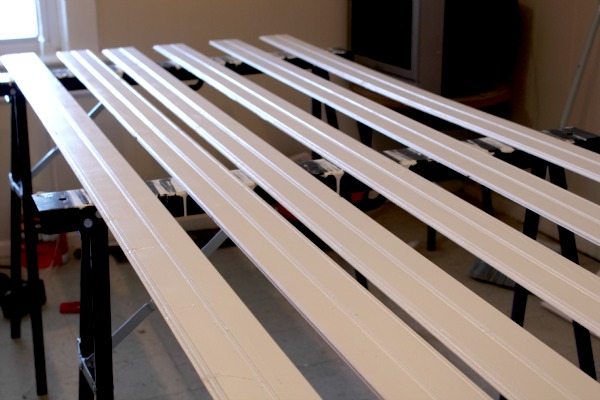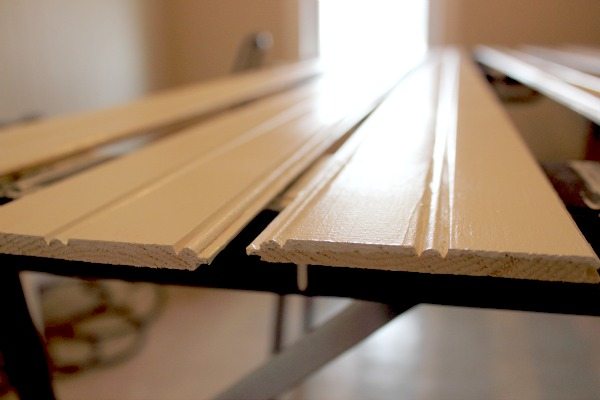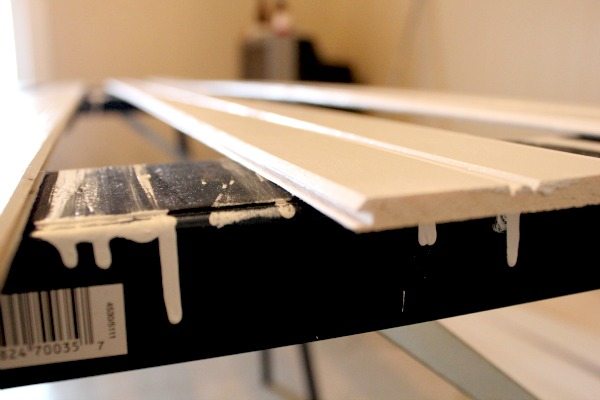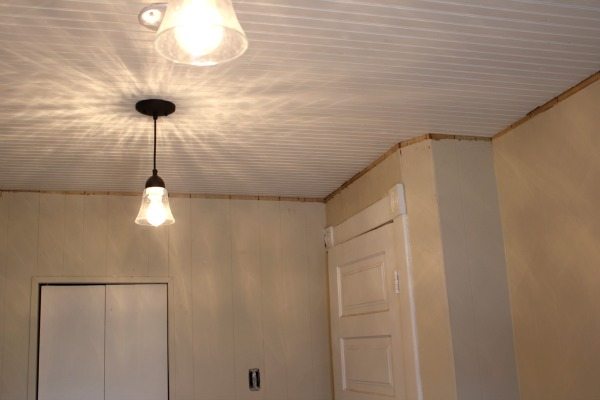Check out my fancy new half of a ceiling!
Nice, right?
Well, we (I) took a break of about a month and a half from the beadboard painting, but I finally got back into it. And I got it done! And I figured out how to do it without losing my mind.
It looks like it should be pretty quick and easy to paint these thin little strips of nothing, but let me tell you: It can get some kinda tedious!
Never fear! If you’ve seen my pretty beadboard and you’ve been thinking about attempting this project too, I have some tips for you!
Tip #1: Set aside a couple of days to get it done. Make them “painting days”. Wear your painting clothes the whole time and just plan to be a general mess. At first, each pack of 6 beadboard strips was taking me about 45 mins total to get done, but it was spread out over a couple of hours including drying time. I was thinking originally that I could just set aside 5 minutes per coat and kind of do it without making a mess hopefully in between all of my regular activities. Well, then it took much longer than 5 minutes per coat (more like 20-25) and sometimes I was wearing clothes that I didn’t want to risk getting painty, because the whole process was a lot drippier than I expected, so it just wasn’t convenient to get done in my day-to-day life. So it didn’t!
Then I took a weekend and made it my “painting weekend” and things got done. I was already set up and in my painting clothes, just went to the room I was working in for 15 minutes at a time or so, then went and did something else for 15 minutes while it dried, then went back. I did 12 packs in one weekend and got a lot done around the house too! So dedicate the time. It’s not as little of a painting job as it seems.
Tip #2: Use cheapo disposable rollers. I had been using a good mini roller before and putting it in the freezer in between coats. The problem is that it got a little too frozen to use right away when I took it out and I’d end up having to wait to defrost it and then I would no longer have the time to do a coat. Another inconvenience, another reason to put off finishing the job! With the cheapo rollers, if I got busy and waited too long between coats and the roller was too crusty, I just got rid of it and started with a new one. That only happened one time, but the point is that it wasn’t something I had to worry about, so I had no excuse to put it off.
Tip #3: The technique. I went over the grooves and the sides first with a good angled brush before rolling. Sounds like a quick little step right? This probably took the longest of anything, but was totally necessary. I had a couple of good non-disposable angled brushes on hand that I switched out and cleaned up if they started to seem like the paint was drying on them too much. I’ll share my super-easy paint brush cleaning technique with you next week. Oh, you just wait!
I saved a good 5 minutes per coat with a little technique I called the “beadboard rule of thirds”. At least that’s what I called it to myself in my head while I was doing it. I basically only painted one third of each board at a time, rather than trying to make the paint on my brush spread out over as much of the board as possible, I just filled my brush, put a few dabs down the center on just 1/3 of the board, used what was left on the brush to do the edges and then came back to the center. And repeat for the remaining 2 sections of the board.
OK, you think I’m a little nuts right now for telling you all that. It’s just slapping some paint on some boards. But seriously, saving those precious seconds made all the difference between me putting off doing the job for weeks and months and actually enjoying getting it done in just a weekend!
Tip #4: Semi-gloss paint will make you happy. I used 2 coats of a medium-high quality paint on them and no primer and they look stunning. Stunning!
Tip #5: Be ready to get messy! Seriously, when I first started out painting, I wrapped my pretty new sawhorses in plastic wrap to try to keep them clean. You can see how well that lasted. Moving the boards around and switching to new boards just did not make it possible to keep the plastic wrap on. The fact that the edges are a little curved and need to be painted since they’ll show a little bit leads to lots of drips. It just does. Set up somewhere you can make a mess and just run with it!
So as much as this was not an easy-peasy project, I still encourage you to give it a go, with the help of my tips of course! If you can make it to the end, the results will be worth it!
Courtenay Hartford is the author of creeklinehouse.com, a blog based on her adventures renovating a 120-year-old farmhouse in rural Ontario, Canada. On her blog, Courtenay shares interior design tips based on her own farmhouse and her work as founder and stylist of the interior photography firm Art & Spaces. She also writes about her farmhouse garden, plant-based recipes, family travel, and homekeeping best practices. Courtenay is the author of the book The Cleaning Ninja and has been featured in numerous magazines including Country Sampler Farmhouse Style, Better Homes and Gardens, Parents Magazine, Real Simple, and Our Homes.
